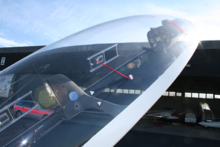Yaw string

The yaw string, also known as a slip string, is a simple device for indicating a
It is typically constructed from a short piece or
The yaw string is considered a primary flight reference instrument on gliders, which must be flown with near zero sideslip angle to reduce drag as much as possible. It is valued for its high sensitivity, and the fact that it is presented in a head-up display. Even the most sophisticated modern racing sailplanes are fitted with yaw strings by their pilots, who reference them constantly throughout the flight.
History
The yaw string dates from the earliest days of aviation, and actually was the first
Operation

In flight, the rule to remember is simple: step on the head of the yaw string, the head is the front of the string, where the string is taped to the canopy. If the head of the yaw string is to the right of the yaw string tail, then the pilot needs to apply right rudder pressure. If the head of the yaw string is to the left of the yaw string tail, then the pilot should apply left rudder pressure. Or think of the attached point of the yaw string as an arrow head pointing to the rudder pedal needing the application of pressure. According to Helmut Reichmann, "...rudder against the string and/or aileron toward the string. In a spin the string always points to the inside." To center the ball on an inclinometer, apply rudder pressure on the side to which the ball is deflected. Use the simple rule, “step on the ball,” to remember which rudder pedal to press.[9][10][11][12][13]
Use on powered aircraft
Yaw strings are also fitted to the
Yaw strings are also used on some (especially smaller) helicopters.
Side string

A variation of the yaw string is the side string, used in gliders for a determination of the angle of attack. In this way the speed for best glide angle, the best thermalling speed and the stall speed can be observed independently of other parameters like air speed, aircraft weight, acceleration due to turning, stick movements, and gusts.[18]
Investigations of the side string and on its use in glider flight were performed by the
See also
- Glider (sailplane)
- Gliding
- Sideslip angle
- Slip (aerodynamic)
- Tuft
- Tell-tale (sailing)
- Critical engine
References
- ^ Reichmann, Helmut (1988) [1975]. Lert, Peter (ed.). Cross Country Soaring (Streckensegelflug) (English ed.). Soaring Society of America. p. 77. LCCCN 77-86598.
- ^ Denker, John S. (2002). "See How It Flies". Retrieved 2007-01-21.
The slip string is commonly referred to as a "yaw string", even though it measures the slip angle, not the yaw angle (i.e. heading)....
- ^ Glider Flying Handbook. U.S. Government Printing Office, Washington D.C.: U.S. Federal Aviation Administration. 2003. pp. 4–14. FAA-8083-13_GFH.
- ^ Selvidge, Harner, S.D. (1976) [1963]. "Ch. 7 : Equipment I". In Licher, Rose Marie (ed.). American Soaring Handbook (2nd ed.). Soaring Society of America. pp. 30–31. LCCCN 59-15668.
{{cite book}}: CS1 maint: multiple names: authors list (link) - ^ Rotorcraft Flying Handbook (PDF). U.S. Government Printing Office, Washington D.C.: U.S. Federal Aviation Administration. 2000. pp. 18–4. FAA-8083-21.
- ^ Hurt, George. "The Yaw String". Retrieved 2007-01-21.
- ^ Wright Brothers Aeroplane Company and Museum of Pioneer Aviation. "1902 Glider Replica". Retrieved 2007-01-21.
For all the progress that has been made in a century of aviation, the Ventur 2 still has a "yaw string" attached where the pilot can see it. As does the Wright glider. This was the first flight instrument....
- ISSN 0827-2557. – 2557. Archived from the original(PDF) on 2005-10-31. Retrieved 2006-01-21.
[Wilbur Wright] responded, "Yes...we will install a short piece of string out front where we can see it. This string will tell us all we need to know!" (paraphrased) Wilbur had just invented the yaw string — the first aircraft instrument.
- ^ "Glider Flying Handbook, FAA-H-8083-13A" (PDF). U.S. Department of Transportation, FAA. 2013. pp. 4–16, 4–17. Retrieved 13 December 2020.
- ^ "Pilot's Handbook of Aeronautical Knowledge, FAA-H-8083-25B" (PDF). U.S. Department of Transportation. 2016. pp. 8–18. Retrieved 13 December 2020.
- ^ Benenson, Tom (2000). "Thermals, Towlines & Tangents". Flying Magazine. p. 103. Retrieved 13 December 2020.
- ^ "Helicopter Flying Handbook, FAA-H-8083-21B" (PDF). U.S. Department of Transportation, FAA. 2019. pp. 9–3, 9–4, 9–5. Retrieved 13 December 2020.
- ISBN 1883813018.
- ^ Schiff, Barry (2006). "High Flight". Retrieved 2007-01-21.
A yaw string (like those used on sailplanes) above each canopy silently admonishes those who allow the aircraft to slip or skid when maneuvering.
- ^ http://www.anft.net/f-14/f14-detail-sensorprobe.htm
- ISBN 0-07-142139-4.
You will see that with the wings level the yaw string does not lay along the centerline, yet the ball is in the center...
- ^ Airplane Flying Handbook. U.S. Government Printing Office, Washington D.C.: U.S. Federal Aviation Administration. 2004. pp. 12–23. FAA-8083-3A.
- ^ Use of the side string, DG Flugzeugbau
- ^ Use of the side string (German), Akaflieg Köln
![]() This article incorporates
This article incorporates
